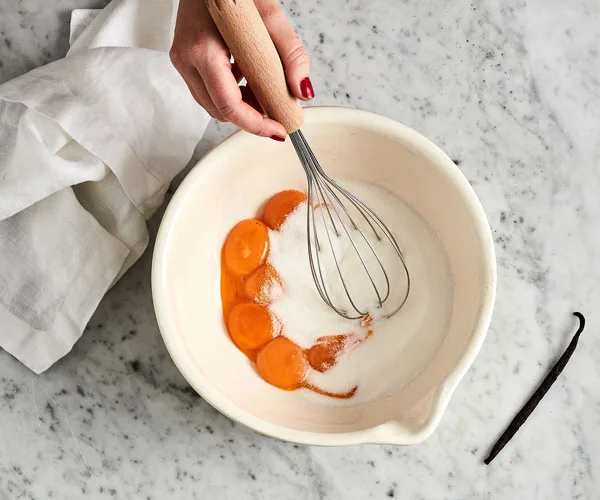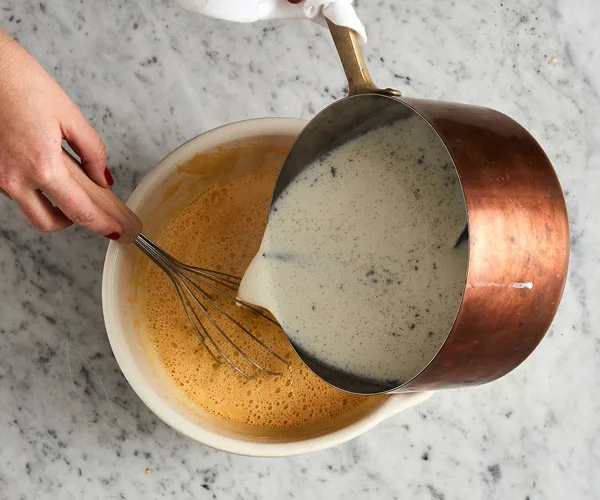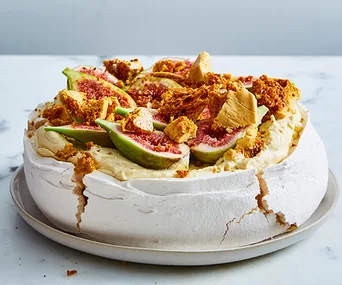To make a custard, or crème anglaise, as it’s also called, the method is quite simple – egg yolks whisked with sugar and cooked out with the addition of milk – but some patience is required. You need to cook the custard over a low heat with a lot of movement to hold the protein together and avoid curdling the mixture. Once the custard is made, chilling it quickly to halt the cooking process will safeguard that perfectly thick, velvety finish.
Cold custard at Christmas time is a favourite for many of us, whether it be spiked with brandy for your Christmas pud, or poured over simply baked stone fruit. It’s also great to keep in the fridge ready to go.
Your base custard can be flavoured with just about anything.
For a traditional Christmas crème anglaise, add a slug of brandy once the custard has cooled (if you add it too soon, it may split). Hazelnut liqueur is also lovely. Adding spice will also give it a really beautiful Christmas flourish – think ground ginger, cloves or a good grating of nutmeg. A seasonal fruit purée, such as raspberry or peach, can be stirred through for a lighter finish. You can also use a golden sugar instead of caster if you want a deeper, more caramelised flavour.
How to make crème anglaise, step by step
Step 1 Place a heatproof bowl over a bowl of ice and set aside.
Step 2 Whisk 8 egg yolks and 150gm caster sugar in a bowl until thick, pale and creamy (about 3 minutes). If you have an electric mixer, beat with the whisk attachment fitted.

Step 2.
Step 3 Bring 1 litre full-cream milk, 1 split vanilla bean with seeds scraped and 50gm caster sugar to a simmer in a large saucepan over medium heat until sugar dissolves. Pour hot milk mixture, in batches, over yolk mixture, stirring to combine.
Step 4 Return mixture to the saucepan. If there are milk solids stuck on the base, use a clean saucepan (if there are minimal milk solids, it will be fine). Scalded milk will taint the flavour of the custard (see tips). Stir mixture continuously over low-medium heat until custard thickens, reaches 82°C and coats the back of a wooden spoon (10-15 minutes; test for thickness by running your finger along the spoon; it should leave a clean line).

Step 3.
Step 5 Immediately pour custard into prepared bowl to stop the cooking process, then stir mixture occasionally until chilled (30 minutes). If serving custard warm, very gently reheat it, stirring continuously to prevent it from splitting. Custard will keep refrigerated for 3-4 days.

Step 5.
Tips:
When whisking eggs yolks and sugar, always have the yolks ready first (as the eggs will “cook” the sugar) and whisk immediately to combine.
Constant stirring when cooking the custard is required to prevent curdling. It’s very important to keep the cooking temperature low to prevent the mixture splitting. Use a flat-edged wooden spoon when stirring, so you can scrape the base of the saucepan well to avoid solids sticking. Stir in a figure-of-eight motion to ensure even cooking.
If your mixture curdles, you can cool it, then blend it with a hand-held blender, but there’s still a chance it won’t re-emulsify, in which case, you won’t be able to cook it any further.
 Will Horner
Will Horner

